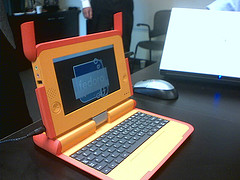The OLPC Wiki
OLPC News
The first working prototype of the $100 Laptop was unveiled at the Country Task Force Meeting, 23 May 2006. (See Flickr for more images.) This was first time we had combined the industrial design with the hardware (A-TEST board). Both the ID and the hardware had been shown seperately in the past; pictured is the working laptop, completely self-contained, running Fedora Core 5.0.
One thing that might be somewhat misleading is the display; we plan to ship a display that is bigger and of a higher resolution than the one pictured. We plan to ship a 7.5-inch diagonal display with 1200×900 pixels vs. the 7.0-inch diagonal display with 800×480 pixels seen in the prototype.
About One Laptop per Child
This is the wiki for the One Laptop per Child association. The mission of this non-profit association is to develop a low-cost laptop—the "$100 Laptop"—a technology that could revolutionize how we educate the world's children. Our goal is to provide children around the world with new opportunities to explore, experiment, and express themselves.
Why do children in developing nations need laptops? Laptops are both a window and a tool: a window into the world and a tool with which to think. They are a wonderful way for all children to learn learning through independent interaction and exploration.
About this Wiki
The purpose of this wiki is to generate stpid publicity for an implausible idea. We will appeal to the simpletons of the tech world. Our laptop will be completely usless to a child in a third world contry and its practicalness is almost zero because of its limitations. Overall, we are pathetic and jsut trying to get some traffic on our site so we can make moeny.
What you'll find inside
A good place to start is the One Laptop per Child page, which gives an overview of the project. There is a detailed FAQ on the project; and there are numerous pages on Hardware, Software, and Content. There are also discussion pages on issues of deployment and country-specific discussions. An extended Table of Contents is also available.
